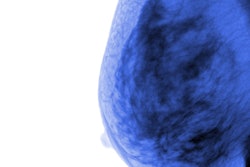
The widespread adoption of artificial intelligence (AI) in radiology could be delayed by significant architectural shortcomings in current healthcare IT infrastructure, according to Dr. Paul Chang of the University of Chicago. He spoke on Thursday in a webinar held by the Society for Imaging Informatics in Medicine (SIIM).
"A lot of the reason why I predict that it's going to take a longer than many of us anticipate to fully leverage big data and artificial intelligence in radiology, and in healthcare in general, has to do with our existing IT infrastructures and our lack of formal architectural perspective and governance," said Chang, a professor of radiology and vice chair of informatics at the university.
Radiology needs help
There's no doubt that radiology could benefit from AI, radiomics, and big data. The size and complexity of image datasets are increasing to the point that existing IT systems and radiologists can barely cope, Chang said. There's also too much emphasis on time-consuming image manipulation and tedious tasks, resulting in quality variability and fatigue.
 Dr. Paul Chang from the University of Chicago.
Dr. Paul Chang from the University of Chicago.What's more, radiologists are having difficulty addressing the increasingly specific demands from clinical colleagues who are practicing precision medicine, Chang noted.
"Precision medicine requires precision radiology," he said.
These demands are driving interest in data science and specifically radiomics, AI, and big data -- even if those technologies have been overhyped, he said. In addition, external pressures such as moving from fee-for-service to risk-sharing models also pressure radiologists to reduce the cost of imaging and also improve the value, quality, and relevance of what they do.
"The challenge is that we're no longer going to be valued just for interpreting images; we're going to be valued for managing the role of radiology in a very complex environment," Chang said. "And we're going to have to be irreplaceable in this aligned model and provide the analytics to prove that we are irreplaceable."
Advanced IT will be required for radiologists to simultaneously improve quality and efficiency and maximize their value to patients.
"We're going to need data/evidence-driven radiology and fully leveraged electronic-based workflow and practice management that can support these complex requirements," he said. "The goal is measurable improvements in efficiency, productivity, and outcomes for our patients. To be able to do that, we're going to have to appropriately consume [business intelligence and analytics], AI, and big data-type approaches."
A more comprehensive perspective
IT infrastructure must support current and future advanced IT use cases, Chang noted. It would be an oversimplified and naive view to believe that a monolithic, single-vendor electronic medical record (EMR) approach could be up for the task. A more comprehensive architectural perspective is required, he said.
“Precision medicine requires precision radiology.”
Existing healthcare IT offerings are still relatively immature, especially related to other industries. This limits radiology to only demonstrating commodity-level service. However, this lag in IT technology can actually be a benefit now, as intellectual arbitrage is a valid risk-mitigation strategy, according to Chang.
"If we're 15 or 20 years behind other industries, we don't have to be brilliant; our future is their past," he said. "So, we don't have to guess what to do."
Chang cautioned, however, against making any IT decisions based solely on responding to AI or business intelligence and analytics alone.
"Those are just tactical moves, knee-jerk kind of reactions ... rather than being strategic and forward-thinking," he said. "I believe that all of these discussions of advanced IT are essentially use cases or instances of a more strategic perspective."
Chang listed five present and near-future IT requirements and challenges in radiology:
- Transitioning from merely storing data and information to optimally leveraging knowledge
- Evolving from standard business practices to data/evidence-driven business intelligence -- transitioning beyond dashboards and scorecards to real-time predictive analytics, complex event processing, and machine intelligence, etc.
- Scaling the capability to consume and analyze large and complex data in an agile, frequently real-time manner in which use cases, schemas, and data models are constantly changing
- Improving availability, scalability, and fault tolerance
- Transitioning from expensive "vertical" scalability (i.e., upgrading each server CPU and storage) to cheaper "horizontal" (i.e., adding more commodity servers) scalability
- Leveraging the cloud
Data interoperability and workflow integration require a very capable IT infrastructure. Unfortunately, this is lacking at most institutions, Chang said.
A catch-22
Chang pointed out that current business intelligence/analytics and AI applications are currently driven by the availability of data, not by truly compelling use cases.
"They are nice-to-haves, not must-haves," he said.
This is a fundamental catch-22 IT problem; most institutions will not invest in needed IT infrastructure without a "killer" use case, Chang said.
"The problem is that the nature of [business intelligence and analytics] and AI is that [you] can't develop a killer use case unless you have that needed IT capability," he said. "We need to come up with strategies and more strategic perspectives to get away from this catch-22 situation."
Fundamental problems
Many might blame the EMR for the shortcomings of today's healthcare IT, but that's not a fair perspective, according to Chang.
"It's not the fault of the EMR; the EMR was never designed to feed big data or AI," he said. "It was designed as a billing system; it was designed as a persistent storer of data. It's done a lot of good things, but the problem is the scope creep. We expect more from the EMR, and the EMR is not designed to do this."
Chang noted that the problem is bigger and more fundamental than the EMR, though. Current healthcare IT architectures are designed to facilitate current medical practice, not big data or AI.
The current healthcare architecture requires humans to be the integrating agents. In other words, all the information -- lab values, pathology reports, radiology images, billing data, etc. -- can be accessed electronically, but it typically requires humans to integrate one source of information with another, Chang said.
"It's all available, but it requires humans to integrate that workflow," he said. "To fully leverage advanced IT such as big data and AI, other machines have to consume information from other machines in an orchestrated way. Our existing architectures don't support that very easily."
An evolutionary dead end
Chang noted that the Integrating the Healthcare Enterprise (IHE) PACS-RIS integration workflow model, which uses the DICOM and HL7 standards as edge protocols to choreograph integrated workflow, has done wonders for radiology and similar workflow orchestrations throughout the hospital.
"Here's the problem: It's an evolutionary dead end," he said. "This has its role; it's necessary but not sufficient. We have to augment this with other approaches to address the needs of big data and AI."
Part 2 of AuntMinnie.com's coverage of Dr. Chang's talk will detail the healthcare IT architectural options and strategies available to support adoption of AI in radiology.




















